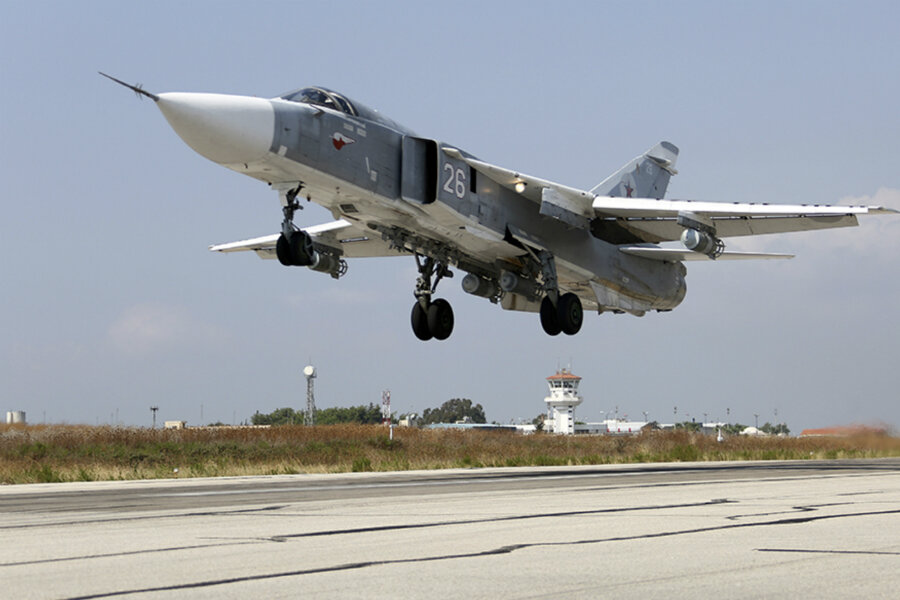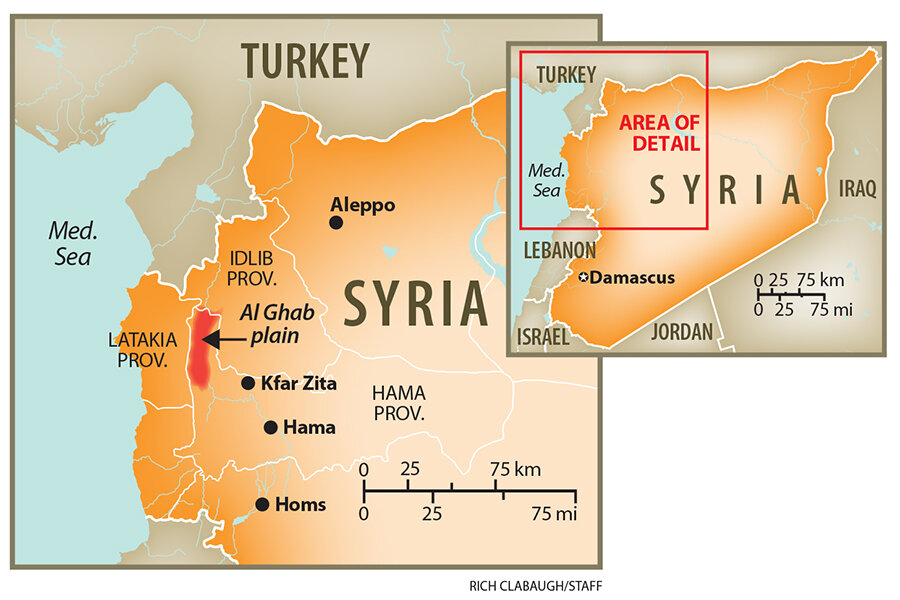Buoyed by Russia and Iran, Syria seeks to reclaim ground. But then what?
Loading...
| Beirut, Lebanon
After months of battlefield setbacks, the regime of Syrian President Bashar al-Assad has begun to push back against the armed opposition, buoyed by an unprecedented level of support from Russia and Iran.
Under the cover of airstrikes carried out by Russian jets and helicopters, and backed by Hezbollah and Shiite paramilitaries from Iraq and Afghanistan, the Syrian Army is attempting to claw back territory it had lost in northern Hama Province.
The offensive, which began last week, is part of a broader campaign to oust rebel groups from all of northwestern Syria up to the border with Turkey, securing the regime’s key territory along the Mediterranean coastline.
“No more defensive fighting. Now we are on the offensive,” says a veteran unit commander from the Lebanese movement Hezbollah, who has served multiple tours in Syria. “We will take many casualties, yes, but the game will be over soon. We will reach the border with Turkey.”
What comes after that – if it is successful – is less clear.
Does the new axis of Russia, Iran, Syria, Iraq, and Hezbollah advance eastward to retake the entire country from the rebel forces and the jihadist extremists of the Islamic State? Or will Moscow settle for strengthening the Assad regime ahead of a potential bid for a political settlement of the 4-1/2-year conflict on terms that suit Russia’s strategic interests?
“If he [Russian President Vladimir Putin] tries to retake the whole country, then he will probably just get another Afghanistan where he can control the main cities but he cannot control the smaller towns and villages, which will be in a constant state of civil war,” says Nikolay Kozhanov, a fellow at the London-based Chatham House and nonresident fellow at Carnegie Moscow Center.
Russia, which began deploying aircraft and personnel to Syria in August in support of Assad, has staged hundreds of airstrikes in the past two weeks against targets across northern Syria.
Moscow says it is attacking “terrorists,” mainly the self-described Islamic State, which controls a large swath of Syrian and Iraqi territory.
However, the bulk of the airstrikes have hit anti-Assad rebels in northern Hama Province and adjacent Idlib Province in a clear attempt to support loyalist ground forces, according to activists and analysts. Several videos uploaded to the Internet over the past week show Russian Mi-24 “Hind” helicopter gunships swooping low over villages in northern Hama, firing rockets or dropping bombs and spewing anti-missile flares.
The Syrian Army and its allies are operating along three main fronts: Hama Province, centered on the rebel-held town of Kfar Zita; Al-Ghab plain, a flat agricultural region just to the west; and the northeastern part of Latakia Province, where loyalist forces are attempting to push back rebel groups from mountains overlooking the coastal region, the heartland of the Assad regime.
Hezbollah said to mobilize thousands
A fourth front appeared to open in earnest Thursday when Russian aircraft staged heavy airstrikes against a rural rebel-held enclave straddling the main highway between the regime-controlled cities of Homs and Hama. Fierce clashes were reported near the town of Talbisah, six miles north of Homs, as Syrian troops and Hezbollah fighters attempted to break the rebel lines.
If the regime prevails in this multi-front offensive, it will secure the communication links between Homs and Hama and force the rebels northward from Hama and eastward from Latakia into Idlib Province.
A fifth, more ambitious, front is expected to open imminently in which the Syrian Army will seek to regain territory in Aleppo. Syria’s second city, Aleppo sits 30 miles south of the Turkish border, and is split between the regime and opposition. According to reports and diplomatic and Hezbollah sources, the Syrian Army will be backed by Hezbollah fighters and hundreds of Iranian troops who were flown recently into the Hmeymim airbase south of Latakia, which has become the primary staging ground for Russia’s military intervention.
Sources close to Hezbollah say that some 3,000 fighters from southern Lebanon have been mobilized in readiness for possible deployment to northern Syria in addition to the existing estimated average commitment of around 5,000 cadres.
Strong rebel resistance
Still, despite the scale of the regime offensive, initial progress has been slow in the face of stubborn rebel resistance.
On Tuesday, Jaish al-Fatah, a rebel coalition that includes the militant Islamist Ahrar ash-Sham and Jabhat al-Nusra, Al Qaeda’s affiliate in Syria, announced the launch of the “battle of liberating Hama.” A statement issued by the faction called on “all the [holy fighters] in Hama to inflame the fronts within their areas to make the Muslim legions meet in Hama, liberating it, God willing.”
The rebel defense has been aided by the reported delivery by Saudi Arabia of some 500 American-made TOW anti-tank missiles, which have been employed to deadly effect against the regime forces. The relatively open terrain in northern Hama and especially Al-Ghab plain hands the rebels a topographic advantage with their line-of-sight TOWs, which have a range of 2.6 miles.
On the first day of the offensive in northern Hama last week, units affiliated with the Free Syrian Army claimed to have destroyed at least 15 tanks and armored vehicles in what it dubbed a “tank massacre.” One of the victims of a TOW missile was Hassan Hussein Al-Hajj, a senior and veteran Hezbollah military commander, who died last week in Idlib Province. Another senior Hezbollah commander was killed two days later.
At least four senior officers with the Iranian Revolutionary Guard Corps also have died in the past week, including Brig.-Gen. Hossein Hamadani, who was killed near Aleppo.
Progress may be slow for Assad's forces, but the current multi-pronged offensive is the first move “in a new game of chess in the Middle East” played by Moscow and Tehran, says a Western diplomat with extensive contacts in Syria.
“There will be counter-moves, and I think the Russian and Iranians will have some nasty surprises coming and stiff resistance ahead of them,” the diplomat says. “But the cooperation between the allies of Assad remains as strong as ever and very operational, with the only real change being that the Russians have a much greater say now.”








